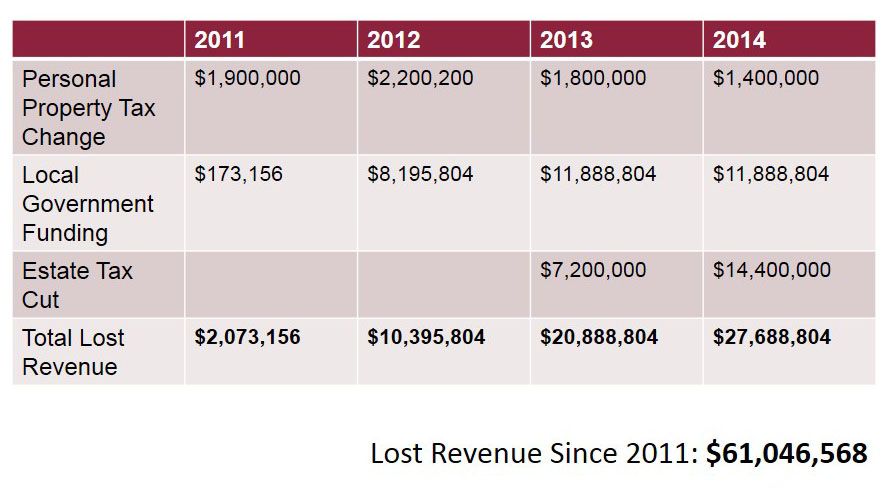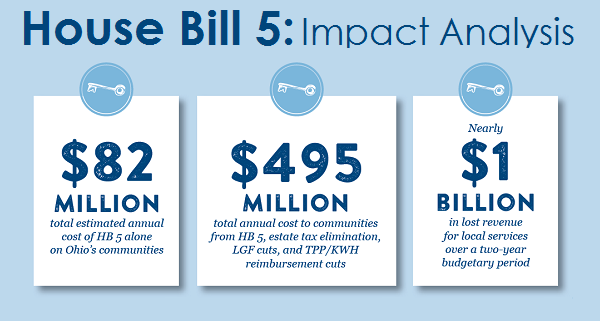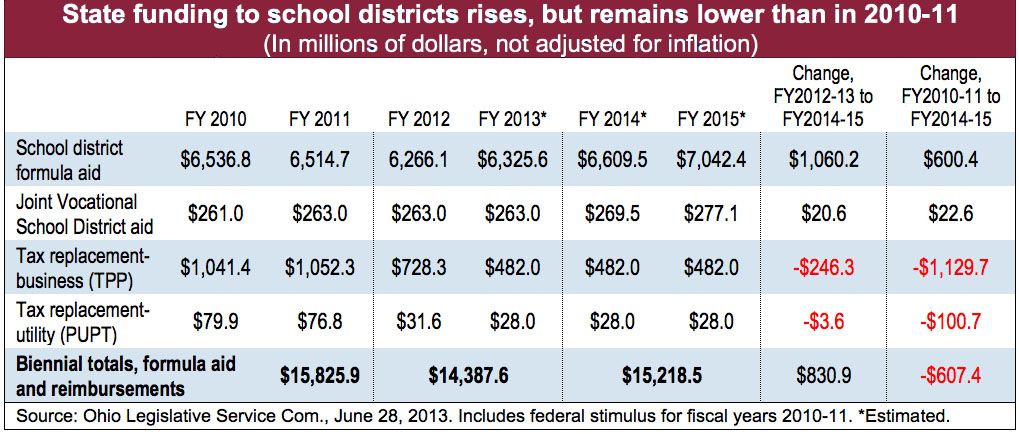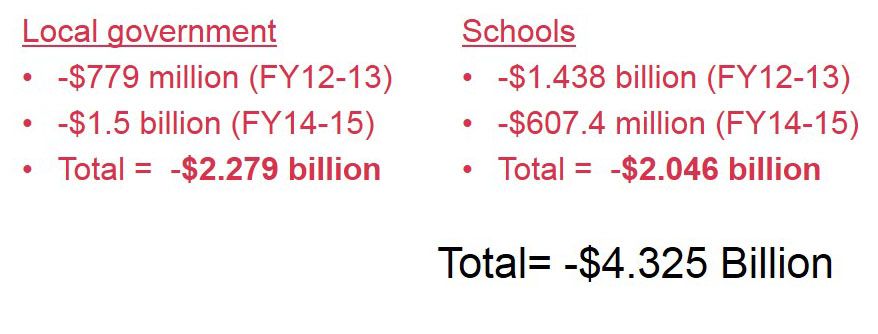State of the State Address : 2015
Governor John Kasich (R) delivers his fifth State of the State Address before a joint session of the Ohio General Assembly in Wilmington.
Articles on Governor Kasich’s State of the State Address:
- Ohio Politics Now: What’s being said about Kasich’s State of the State | Columbus Dispatch
- Kasich: ‘You won’t get lower taxes’ without hikes | Cincinnati.com
- John Kasich’s State of State speech suggests fiscal conservatism has replaced compassionate conservatism as his 2016 calling card: 5 observations | cleveland.com
- Kasich touts latest budget proposals in State of the State | The Toledo Blade
- If tax cuts answered Ohio’s problems, its troubles would have ended long ago | Editorial by Thomas Suddes | The Cleveland Plain Dealer

Governor Kasich delivered his State of the State speech in Wilmington, Ohio, last night.
Unfortunately, the state of the state can be summed up in four words: trickle down doesn’t work.
Ohio’s recovery is lagging other states because wages remain stagnant, too many working families continue to struggle, and Gov. Kasich keeps asking those with the least to pay more in order to fund tax cuts for those doing well.
The latest budget proposal is more of the same: in Wilmington, the average family will have their taxes raised by $122 in the Governor’s latest tax plan.
As Senate and House Leaders Schiavoni and Strahorn have made clear, the path to prosperity in Ohio requires the opposite approach.
Focus on middle class prosperity—increasing wages, improving schools, investing in infrastructure, respecting working families—and then the state of the state will ultimately be strong.
Stay connected with the Ohio Democratic Party on Facebook and Twitter to be in the loop on how we are working every day to improve the state of our state.
Sincerely,
David Pepper
Chairman, Ohio Democratic Party
An Analysis by Innovation Ohio
Gov. John Kasich has made Wilmington the site of his fifth
State of the State address and has described Wilmington’s story
of economic recovery as Ohio’s story of economic recovery.
While unemployment in Wilmington has dropped,
it is important to look more closely at the local economic picture and
how recent state policies have impacted this quintessential Ohio community.
How Ohio Pulled $4 Billion+ from Communities
Editorial: Daily Kos | February 25, 2015
Monday night Ohio Governor John Kasich delivered his state of the state speech.
He cribbed the biblical Reagan “city on a hill metaphor” to describe Ohio:
All of these things have helped Ohio move up to higher, more solid ground, and, if you look, the clouds are moving apart and the sun is beginning to shine, and we can get a glimpse of the summit ahead. We’ve got much further to go, but the success we’ve had gives us the confidence to climb higher. We’re not hopeless, we’re hopeful. We’re not wandering, we have direction. Let’s keep going.
As an Ohioan, I’d like to tell a different story.
It’s a story that appears in bits and pieces in city & school financial reports, in letters to the editor and editorials, in economic analyses, but the full story has largely hid from public sight because it’s not a single sensationalist event.
It’s not a story about a person or administration because you have to go back further than that to see the pattern.
You have to go back further than that to see how a state gets budgeted back to the stone age.
The pattern is simple but takes place over a long period of time: shift tax burden, create deficit, blame government, defund government, repeat.
And unfortunately, it’s a story that’s not just happening in Ohio, but at a national level and in many states across the nation because it’s being pushed by influential corporate groups like the American Legislative Exchange Council (ALEC).
The story begins in 2005 …
2005
The Ohio General Assembly passed House Bill 66 promising to improve economic conditions for Ohioans.
H.B. 66 eliminated the corporate income tax and reduced state income taxes by 21%.
Governor Taft from his 2006 state of the state speech:
At this time last year we had a tax code that was mired in the distant past, punishing investment and ignoring innovation. We worked day and night to bring that code into the 21st Century. We cut the income tax. We junked the corporate franchise tax. We scrapped the inventory and equipment tax.
The promise was jobs and growth.Impact of H.B. 66
Who benefited from the tax cuts? According to an editorial in the Toledo Blade:
Most Ohioans got little benefit from the tax overhaul. Middle-income Ohioans receive, on average, a refund of $182 a year. The income tax cuts most benefit the wealthy — Ohio’s top 1 percent typically get $10,000 a year in state tax relief — while services that low-wage earners especially rely on get cut.
Did H.B. 66 work? Did it create jobs?In April 2013, Policy Matters Ohio looked at the data to see how Ohio was performing versus other states.
The report is not great.
From 2005 to 2013, we’ve had a 4.4% decline and have lost 238,000 jobs. Over the same period, despite the recession, the nation managed a 1.2% increase. Ohio missed out on pre-recession growth and has been slower to recover. Overall, Ohio ranked fourth-worst in the nation.
Zach Schiller testifying to the Ohio house in 2014:
In June 2005, income-tax rates were cut 21 percent and major business taxes were slashed. Whether one begins with the approval date, the beginning or end of the recession, or since the beginning of this administration in January 2011, the results have been the same: The Ohio job market underperformed the nation. Since June 2005, we have lost a greater share of our jobs than all but two other states, Rhode Island and Michigan. Since January 2011, Ohio private-sector employment growth has trailed behind the country’s, at 3.97 percent compared to the U.S. increase of 6.44 percent.
Nine years after the 2005 tax cuts, we trail the rest of the nation on growth and jobs. In the recent Gallup well-being index, Ohio ranked 46th out of 50 states in 2013.
The story doesn’t end with the 2005 tax cuts though. In 2010, Ohio elected a new governor and state legislature.
The 2010-11 “Jobs Budget”
After winning election in 2010, Governor John Kasich introduced his “jobs budget”: H.B. 153. He claimed there was an $8 billion deficit and proposed massive cuts to local governments and schools. The following chart shows the impact of his cuts to the Local Government Fund (LGF). The LGF funds are distributed to cities and municipalities throughout the state. Casino money was dangled before local communities as a way to make up the difference, but as the following chart shows, it hasn’t.
Casino money was dangled before local communities as a way to make up the difference, but as the following chart shows, it hasn’t. Example: Cincinnati Let’s look at Cincinnati to see how this impacted one of Ohio’s cities. The following table shows the cuts to the local government fund (GRF) from eliminating the estate tax and from changes to the personal property tax.
Example: Cincinnati Let’s look at Cincinnati to see how this impacted one of Ohio’s cities. The following table shows the cuts to the local government fund (GRF) from eliminating the estate tax and from changes to the personal property tax. Since 2011, the city has lost over $61 million in revenue. In the 2013 budget, the city manager of Cincinnati wrote:
Since 2011, the city has lost over $61 million in revenue. In the 2013 budget, the city manager of Cincinnati wrote:
If we did not have the loss of these three income sources, the City of Cincinnati’s short-term budget outlook would be very different. In fact, we could essentially be balanced without extraordinary measures.
What he meant by “extraordinary measures”:
The cumulative effect of all the permanent and one-time cuts that have been made over the past several years are still being felt. As a result service delivery and performance in many areas is slower and occurs without enough people, requiring a focused effort to keep errors to a minimum. A good example of this is the Purchasing Division in the Finance Department. In 2007, there were six employees serving as buyers to help procure services and goods under contract. In 2012, there are four, a difference of 4,176 hours of staff time lost per year in that area. Contracts for services such as street rehabilitation, demolitions, and professional services now take longer to process. … To balance this budget exclusively with cuts would require the elimination of 344 positions.
This, after the size of city government has been cut roughly in half since the 1990s according to David Mann, Cincinnati’s vice mayor.Since 2000 alone, according to the city report Striving for Structural Balance: Assumptions and Options, full-time employees in recreation have been cut by 43%, transportation and engineering by 62%, IT solutions by nearly 75%, public services by 43%, finance by 43%, and the city manager’s office by over 40%. The cuts have impacted city pools and parks, economic development services, fire and police, traffic and parking, just about every service you can think of that government provides.
The city also sought to privatize its parking meters to bring in increased revenue, a plan that has since been shelved. Other fees will likely follow however.
Now imagine a similar scenario playing out in cities and towns across Ohio. Increased fees, increased local property taxes and decreased services. Or click here if you live in Ohio to see the effects and impacts on your county.
Changes to School Funding Since FY10-11
Similarly, schools districts faced significant cuts from 2012-2014.
Funding was cut by $1.438 billion for the 2012-13 budget. Though some of it was restored for the 2014-15 budget, the projected total is still $607.4 million short of 2010-11 funding.
Across Ohio, teachers and programs were eliminated or reduced. Class sizes went up and school districts proposed local property tax increases to make up for the lost revenue.
Totals from 2012-2015
To summarize briefly, here’s how the Ohio government has defunded schools and communities since the 2010-11 budget:
An Important Note about that $8 Billion Deficit
In 2010, the Kasich administration claimed that Ohio faced an $8 billion deficit crisis.
What never gets mentioned is that if there was an $8 billion deficit, it was created by the income tax cuts of 2005 and a recession.
The 2005 tax cuts reduced revenue with the assumption that the economy would grow and Ohio could bring in more money from a lower rate. However, the economy didn’t grow. It crashed. Quite simply, by 2010, the recession and the 21% cut combined to create the state deficit.
Where Did the Money Go?
In the 2012-13 budget, Ohio paid for an estate tax cut which dropped revenues by another $333.8 million a year. The state also increased funding to charter and private schools by $567 million.
2012-13
• $333.8 million to fund the estate tax cut. (Benefits only those with estates of more than $338,333.)
• $770 million for charter and private school vouchers
Total: $1.1 billion
Spending from the General Revenue Fund also increased from $50.5 billion to $55.6 billion over 2 years.
This is an increase of $5 billion, the second largest increase in state spending in Ohio’s history.
As Kasich’s own Budget Director Tim Keen said:
I fully realize that it’s kind of counter-intuitive that we’ve closed an $8 billion shortfall and yet spending is growing.
Indeed. Some might even say there wasn’t an 8 billion deficit.
In 2013, the state government claimed the cuts to schools and local governments worked. No one is talking about a deficit and suddenly the state has a surplus. So we can restore funding to schools and local governments then, right?
Nope. You can probably guess what’s coming.
2014-15
• $2.28 billion, income tax rate cuts
• $1.09 billion, 50% tax break for small business owners up to $250 K
Total: $3.37 billion
You win the prize if you said tax cuts.
Despite evidence that income tax cuts don’t grow the economy or create jobs, the solution is more tax handouts.
It looks more like pursuing an agenda of what the national chamber of commerce wants over education, public courts, police, fire, infrastructure and other programs which benefit the citizens of Ohio.
If you diagram the changes out since the 2010-11 budget, it looks like this:
And yes, I know the numbers don’t equal each other. This is because the state is not directly taking all of the money from one place and allocating it to another. It’s more as if the money is put into a pot and then reallocated. It is interesting, however, how the money taken from schools and communities compares with the money outlays for tax changes and private schools.
In the past 2 budgets (2012-13, 2014-15), Ohio has cut over $4 billion from the public sector and increased spending on charter schools and tax changes by nearly the same amount.
Do you see the pattern?
• Shift tax burden
• Create deficit
• Blame government
• Defund government
• Fund additional tax changes
• Repeat
Cuts to schools and government services are being used to pay for the tax changes groups like ALEC desire.
It looks very similar to what’s happened at the national level with the sequester. Create deficit, use crisis to change tax code. Deficits or where the money will come from are rarely brought up when talking about tax changes.
The American Legislative Executive Council (ALEC) is pushing similar changes across the country with 2013 successes in: Alaska, Florida, Idaho, Indiana, Iowa, Kansas, New Mexico, North Carolina and Wisconsin among others.
Not All Tax Changes Are Created Equal
Now I could almost buy the sales pitch that this is our money and we should get it back except for one thing.
Most people won’t see any difference in their lives from the tax changes.
Why? Because the way the tax changes work is through income tax cuts (which benefit the wealthy most) and sales and local property tax increases (which impact everyone else).
When you look at the impact of the tax changes in Ohio, the gains mostly go to the top 4%. If you make more than $143,000 a year, you receive a $1,000 cut and if you make over $335,000 a $6,000 cut.
Everyone else sees little change as income tax cuts are canceled out by increases in the state sales tax.
BTW, the above chart does not show the additional benefit to those with property valued over $338,333 (who no longer have to pay an estate tax) or the impact of local property tax increases as communities raise them to try to make up for lost funding.
If you were in the top 1%, you received a $10,000 yearly tax cut in 2005 and another $6,000 yearly tax cut in 2014. If you owned property worth more than $338,333, you also received an estate tax cut in 2013.
What’s Next?
Where’s the jobs? Where’s the growth?
Once again, from 2005 to 2013, we’ve had a 4.4% decline and have lost 238,000 jobs. Over the same period, despite the recession, the nation managed a 1.2% increase.
Not even the logic that tax cuts create jobs make sense.
If you own a business, you hire people when you have a need or when there’s increased demand. You don’t hire people when someone hands you a check.
Now you might spend this check. That could stimulate the economy. However, if you’re going to offer a Keynesian stimulus, a better way to do it would be to put the money in the hands of people who will spend it immediately, not the top 4%.
Instead, Ohio is shifting the tax code so the wealthy pay less and everyone else pays more and defunding local governments and schools.
Any guesses what’s going to be proposed next?
I’ll give you a hint. Arthur Laffer, is making the rounds selling a 0% income tax rate, even though this goes against his own Laffer Curve from the ’80s.
Who do you think this will benefit?
“Once you realize that trickle-down economics does not work, you will see the excessive tax cuts for the rich as what they are—a simple upward redistribution of income, rather than a way to make all of us richer, as we were told.” – Ha-Joon Chang, Economist, University of Cambridge
Take action
- Find out what changes are going on in your state and who pays
- In Ohio
- Write a letter to the editor to help people understand the issue and to prod local media.
- Go after the idea of supply side economics not a specific person; refrain from ad hominem attacks and wasted energy liberal/conservative fights.
- Our strength is in numbers, not money. Talk to your friends/relatives and encourage them to do the same. I can’t overemphasize the importance of this.
- Unelect/don’t elect politicians who believe in supply-side economics. A few questions for politicians:
- Why are we talking about taxes again when the last round (or rounds) of tax cuts created a deficit and didn’t deliver on jobs and growth?
- What are you doing to help consumers and the middle class?
- Do you believe that we all benefit when we invest in schools and communities?
At a community forum this past weekend, I was impressed by people speaking out about the impacts at the local level. This is a great sign as the story is starting to get out there. There’s still a lot more to be done though to reverse 40 odd years of supply-side economics.
How much has Governor Kasich cost our local community?
Check out the cost to all 88 counties over the last four years!
Take a look at Cuts Hurt Ohio.
BUDGET UPDATE
here are few notable editorials, news clips and policy facts.
|
|
 “A sales tax increase bites those at the lower income rungs much harder.”
Editorial: Kasich, the Tax Shifter
Akron Beacon Journal, 2/11/15
|
|
“Poorer districts should get more money, but it should not come at the expense of often struggling suburban districts that are just climbing out of the Great Recession.”
Editorial: Kasich’s school funding plan is a puzzle
Northeast Ohio Media Group, 2/10/15
|
|
|

HB 5 Continues Assault on Local Services, Pushes Total Cut to Communities to $495 Million a Year
IO report shows cumulative impact of HB 5 and previous 4 years of cuts to communities
November 20, 2014 | Keary McCarthy, Innovation Ohio
COLUMBUS – Innovation Ohio released a report today that shows the cumulative financial impact of House Bill 5, along with previous cuts to local communities passed in the last two state operating budgets. The report estimates that passage of House Bill 5 alone would cost communities $82 million a year, and when combined with previous cuts, the total impact on local services approaches nearly half a billion dollars annually.
“Our state is only as strong as our schools and local communities,” said Innovation Ohio President Keary McCarthy. “Taken in context with the last four years of significant funding cuts to local communities, passage of House Bill 5 could have serious impacts on services that keep our streets safe and our communities strong.”
Over the last four years, the state has cut an estimated $413 million each year for Ohio’s cities and villages through reductions in Local Government Funding, reimbursement losses for TPP and KWH tax, and the elimination of the estate tax. Combined with an estimated $82 million in annual revenue loss from House Bill 5, the total impact on municipal services is estimated at $495 annually or nearly $1 billion of a two-year budgetary period.
“Republican and Democratic leaders in the Dayton region stand united in our belief that continued cuts to local communities have seriously harmed our ability to provide essential services such as police and fire protection, road paving and infrastructure repair,” said Dayton Mayor Nan Whaley. “Loss of these services impact the quality of life for our constituents and the ability of our small businesses to thrive.”
The report shows the estimated impact of House Bill 5 for 187 municipalities that have provided impact assessments, along with the specific funding cuts from the estate tax elimination, cuts to the Local Government Fund, and TPP and KWH reimbursement losses. The report also shows these cumulative estimated losses as a percentage share of the municipal budget. For the cities of Dayton and Cincinnati, these cumulative losses represent nearly 10 percent of its overall budget.
“House bill 5 needs to be amended to stop cutting resources for local governments,” said Cincinnati Mayor John Cranley. “The death by a thousand cuts coming from Columbus must stop.”
For the cities that did not report estimated impacts from HB5, Innovation Ohio calculated the revenue impact per capita for the cities for which estimates are available to the population of the state’s remaining 429 communities that levy an income tax. Combined, we estimate the potential statewide impact of HB 5 on cities and villages that levy an income tax at over $82 million each year.
“The state legislature’s continued attempts to cut funding and hamstring communities is making it harder to keep our streets safe and our taxes low,” said Marion Mayor Scott Schertzer. “Passing House Bill 5 without making reasonable changes that would limit the financial impact for communities would be yet another hit that everyday Ohioans will undoubtedly feel.”
Read the report: “House Bill 5: Impact Analysis“

Innovation Ohio Budget Briefing
We offer our initial take on yesterday’s state budget proposal which, in our analysis, favors those at the top, but leaves more and more Ohioans behind.
Budget Briefing: Proposals Impacting Women
Gov. John Kasich’s proposed budget provides additional funding for child care, preschool and maternal health and funds training for public colleges and universities to deal with sexual assaults. But it threatens healthcare coverage for low-income women including those become pregnant or are diagnosed with breast or cervical cancer, puts the employment of thousands of women at risk, and features a tax shift that makes those at lower incomes pay even more.
Budget Briefing: Funding Impacts of Charter Schools
Gov. John Kasich’s proposed budget provides only a modest overall net increase in education spending, with fewer than half of Ohio school districts seeing funding increases. However, when funding to charter schools is factored in, one in three of those districts will see their increases erased.
Budget Briefing: K-12 Education Highlights
Governor Kasich’s budget proposal adds $700 million to schools, but the amount is offset by cuts in reimbursements for lost taxes and increased deductions for charter schools. Check out our analysis of the major education proposals in the budget proposal.
Ohio Tax Code Becoming More Regressive
To pay for income tax cuts that primarily benefit the wealthy, the Governor’s budget proposes raising the state’s regressive sales tax and expanding it to more services — including parking and cable TV subscriptions. We crunched the numbers and show how the state’s tax code has become far more regressive in six short years.








